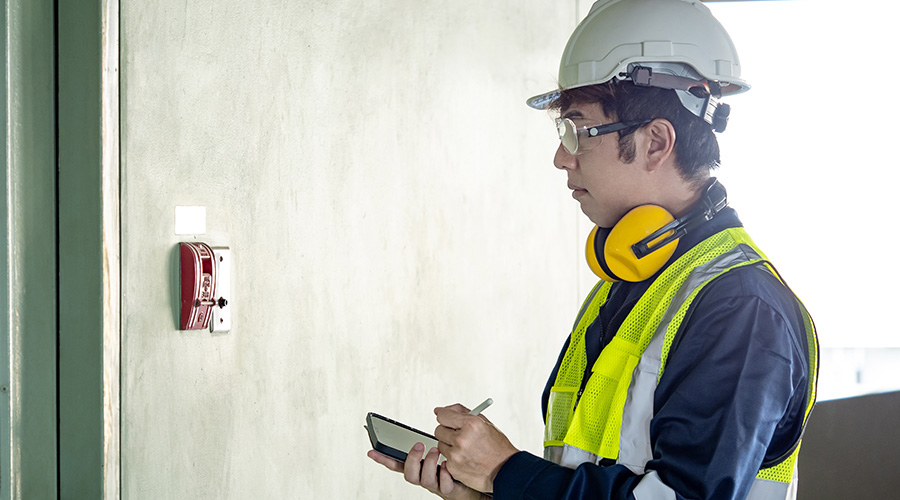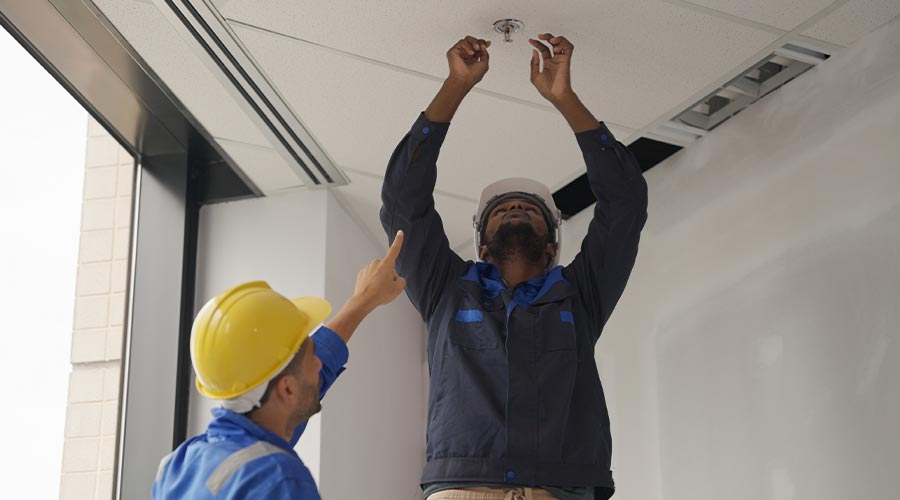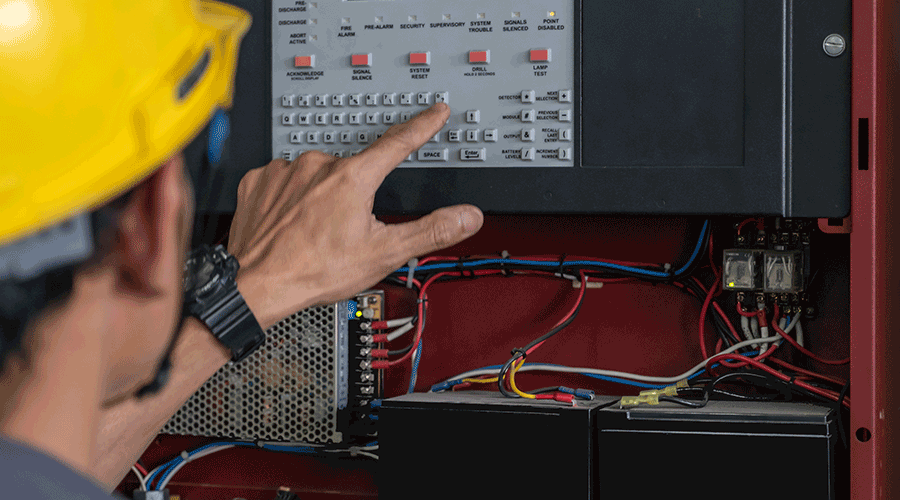Lines of Defense
Sprinklers make headlines for their effectiveness, but they’re only one aspect of balanced fire safety design
What’s the most important part of a fire/life safety system? For some facility executives, that question may call to mind the fire in the Meridian Building in Philadelphia in 1991. A fire broke out on the 30th floor and rose unchecked, threatening to devour the entire 60-story structure. But the 38th floor had sprinklers, which stopped the flames and saved the rest of the building.
There’s no doubt that sprinklers are vital to fire protection. Just last month, nine firefighters were killed at an unsprinklered warehouse in Charleston, S.C. But when it comes to protecting buildings, they’re not a solo act. Passive fire protection systems — such as fire rated walls and doors, fire stops, dampers and smoke management systems — help contain the fire and minimize the damage a fire could cause.
But it’s not enough simply to install fire safety systems. A sprinkler system, once installed, is easy to forget about. Failures of plumbing, electrical and HVAC systems can be conspicuous. But with a sprinkler system, it’s all too easy to overlook maintenance.
The passive components of a fire and life safety system are even less visible. When it comes to maintenance, these systems are too often out of sight and out of mind.
For facility executives, the challenge is two-fold. They must ensure that fire/life safety systems, both active and passive, are designed with the building’s occupancy and potential hazards in mind. Equally important, facility executives must take steps to maintain the technologies once they are installed.
Sprinkler Reliability
Sprinklers are a building’s first line of defense against a fire.
“If it is properly designed, a sprinkler system should be able to control any fire,” says Bob Spaulding, assistant vice president, FM Global.
That’s true, says Chris Jelenewicz, engineering program manager, Society of Fire Protection Engineers. But the effectiveness of a sprinkler system depends on how appropriate it is for the design of the building.
“It’s important to make sure the sprinkler system is designed to meet hazards in the building,” says Jelenewicz. “Designed properly sprinklers are very reliable. If the system is designed poorly, reliability can decrease significantly.”
One potential trouble spot is the water supply for the sprinkler system.
“It’s possible that the system was not designed with the water supply in mind, and the supply is not adequate,” says Jelenewicz. “Or it could be that the water supply changed over time, and is no longer adequate.”
But the biggest risk to sprinkler reliability isn’t poor design. It’s improper maintenance. The leading cause of sprinkler failure, for example, is a valve being shut off for testing or maintenance and then not being turned back on, say experts.
Preventing Problems
The best way for facility executives to ensure that a sprinkler system will be ready when needed is maintenance testing in accordance with NFPA 25. Sprinkler maintenance and monitoring should be done at different benchmark points throughout the year, says Tony Petrillo, associate partner, Syska Hennessy.
“Most inspections and testing should be done monthly — reading gauges, making sure alarm and control valves are accessible and undamaged,” says Petrillo. There is also the main drain test, which should be done annually to ensure that the correct amount of water is available and that the pipes are in good condition. According to Ken Ipsham, vice president of engineering, National Fire Sprinkler Association, using outside contractors is one way to ensure maintenance is kept up.
“Maintaining sprinkler reliability requires a comprehensive schedule of maintenance, and the quarterly and annual tests are more difficult,” he says.
Simple visual observation is another way to ensure that a sprinkler system is maintained properly. Rust, corrosive chemical build up and vandalism can prevent sprinkler heads from activating when needed. The ceiling around the sprinkler heads also needs to be maintained.
“Heat has to collect at the ceiling so that the sprinkler head gets activated,” says Jeff White, partner at CLNW Engineers. “If you have missing ceiling tiles, heat will go right past the sprinkler head.”
Containment Strategy
Although sprinklers are the only system that will actually extinguish a fire, the passive components of a fire and life safety system will help control the spread of a fire and minimize the damage, as well as buy valuable time until the fire department arrives.
Passive systems include fire barriers, fire walls, fire doors, and fire stop systems. “It’s important that all these systems are designed properly so that they operate as one life safety system,” says Jelenewicz.
Passive systems can also help the sprinkler system work as intended.
“Fire barriers enable sprinklers to limit fire growth by containing the spread of the fire, and sprinklers help maintain fire barriers’ integrity for a longer time,” says Craig Studer, vice president, RJA Associates.
In recent years some building codes have permitted building owners to forgo or cut back on certain passive systems in applications where sprinklers are installed. As a result, sprinklers can provide some design flexibility — for example, egress paths can be longer or ceiling height can be higher in a building that is sprinklered.
Jelenewicz notes that there are some equivalencies or tradeoffs in fire protection measures that allow the elimination of fire rated materials. For example, where a fire rated corridor may have been required, installing sprinklers may allow the building owner to have unrated corridors. In some cases, the tradeoff is a lower rating.
“For example, where you might need a type 5 one-hour rated construction, you could use type 5 unrated construction if there are sprinklers present,” Studer says. “The decision to substitute depends on what the occupancy is.”
These tradeoffs are a concern for some fire stop experts. Some say that what is truly important is a well-rounded fire and life safety system that addresses all aspects of a potential fire hazard.
“Sprinklers are a good measure, but they’re not the only measure,” says Richard Licht, chairman of the code action committee of the International Firestop Council. “By getting rid of passive systems you are putting all your eggs in one basket.”
One concern in cutting back on passive fire protection measures is that sprinklers, although very reliable, aren’t infallible. They are enormously effective when they operate properly, but if they fail, the potential for damage and loss of life could increase when passive measures are reduced.
Also, while routine maintenance and diligent monitoring can help offset human error, there are some applications where sprinklers may not be enough, and passive containment methods can add an extra layer of protection. White gives an example of a warehouse environment where the estimated fire load may change over time. In this situation, fire rated doors and construction could help contain the fire if the sprinklers were unable to handle the load. According to a USA Today report, the furniture store in Charleston, S.C., had an increased volume of inventory due to a sale, which added to the normal fire load.
Behind the Scenes
According to Licht, it’s important for facility executives to be aware how passive systems contribute to fire safety, because they are not as visible as sprinklers.
When sprinklers contain the fire, it’s something you can point to and say that it worked, says Licht. “But a passive system is hidden. You can’t see if a fire door did its job.”
A report produced by the National Fire Protection Association in August 2005 recommends that a building’s fire protection system address five aspects of fire protection: slowing the growth of a fire, automatic detection, automatic suppression, confining the fire and occupant evacuation. Sprinkler systems have an important role, as do passive systems.
Jelenewicz agrees, and says it is important to view a life safety system holistically, with sprinklers as one component, and fire rated walls and doors, alarm and detection systems and smoke management systems as other necessary elements.
“Passive systems are part of building codes,” he says. “It is important that all these systems are designed properly so they operate as one life safety system.”
Licht says that designing an effective life safety system means using the appropriate construction for the appropriate application.
“A one-story building is different than a five- or 10-story building,” he says. “You have to consider egress paths, how hard it is to get out of a building — not necessarily putting fire doors and passive systems in every situation, but where it makes sense for the user.”
Maintenance is the Key
Just as maintenance is crucial for sprinklers to operate effectively, it is important that facility executives attend to the maintenance of passive fire systems. This means being aware of how systems have been altered over time, and making sure that when walls or doors are altered to accommodate renovations or upgrades, the integrity of the passive system is maintained.
“One problem is that when a building is built, you have all the passive systems the way they should be, but when people run new piping, those new holes need to be sealed,” says Studer. “The barrier is only good if the original integrity is maintained.”
Fire caulking and sealants where ducts or pipes go through a firewall are extremely important for maintaining the wall’s ability to contain a fire and contain smoke, and are not an appreciable expense.
Statistics show that buildings have become safer over the past few decades as requirements for fire/life safety systems have become more stringent. Wider use of sprinklers has captured the lion’s share of attention, but that isn’t the only measure that has made an impact. Another example is the requirement to seal penetrations in fire-rated walls.
“We used to put buildings up with open seals,” Licht says. “Seal penetration didn’t become enforced until the 1990s.”
The point for facility executives isn’t that one step is better than another. Rather, it’s that a range of fire/life safety measures are vital to protecting people and property in buildings.
Related Topics:











